Comet C/2014 Q2 Lovejoy
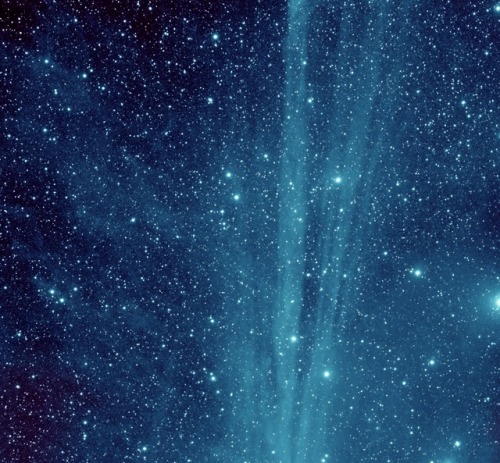
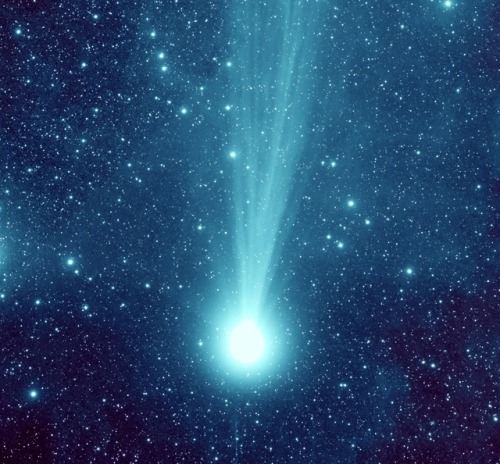
Comet C/2014 Q2 Lovejoy
by Joseph Brimacombe
More Posts from Riekod and Others
the fact that stars even exist and we can look at them every night for free just makes me go !!!!!!!!!!!!!!

Pale Blue Dot
Look again at that dot. That’s here. That’s home. That’s us. On it everyone you love, everyone you know, everyone you ever heard of, every human being who ever was, lived out their lives. The aggregate of our joy and suffering, thousands of confident religions, ideologies, and economic doctrines, every hunter and forager, every hero and coward, every creator and destroyer of civilization, every king and peasant, every young couple in love, every mother and father, hopeful child, inventor and explorer, every teacher of morals, every corrupt politician, every “superstar,” every “supreme leader,” every saint and sinner in the history of our species lived there–on a mote of dust suspended in a sunbeam.
The Earth is a very small stage in a vast cosmic arena. Think of the rivers of blood spilled by all those generals and emperors so that, in glory and triumph, they could become the momentary masters of a fraction of a dot. Think of the endless cruelties visited by the inhabitants of one corner of this pixel on the scarcely distinguishable inhabitants of some other corner, how frequent their misunderstandings, how eager they are to kill one another, how fervent their hatreds.
Our posturings, our imagined self-importance, the delusion that we have some privileged position in the Universe, are challenged by this point of pale light. Our planet is a lonely speck in the great enveloping cosmic dark. In our obscurity, in all this vastness, there is no hint that help will come from elsewhere to save us from ourselves.
The Earth is the only world known so far to harbor life. There is nowhere else, at least in the near future, to which our species could migrate. Visit, yes. Settle, not yet. Like it or not, for the moment the Earth is where we make our stand.
It has been said that astronomy is a humbling and character-building experience. There is perhaps no better demonstration of the folly of human conceits than this distant image of our tiny world. To me, it underscores our responsibility to deal more kindly with one another, and to preserve and cherish the pale blue dot, the only home we’ve ever known.
– Carl Sagan
“The most powerful determinant of whether a woman goes on in science might be whether anyone encourages her to go on. My freshman year at Yale, I earned a 32 on my first physics midterm. My parents urged me to switch majors. All they wanted was that I be able to earn a living until I married a man who could support me, and physics seemed unlikely to accomplish either goal. I trudged up Science Hill to ask my professor, Michael Zeller, to sign my withdrawal slip. I took the elevator to Professor Zeller’s floor, then navigated corridors lined with photos of the all-male faculty and notices for lectures whose titles struck me as incomprehensible. I knocked at my professor’s door and managed to stammer that I had gotten a 32 on the midterm and needed him to sign my drop slip. “Why?” he asked. He received D’s in two of his physics courses. Not on the midterms — in the courses. The story sounded like something a nice professor would invent to make his least talented student feel less dumb. In his case, the D’s clearly were aberrations. In my case, the 32 signified that I wasn’t any good at physics. “Just swim in your own lane,” he said. Seeing my confusion, he told me that he had been on the swimming team at Stanford. His stroke was as good as anyone’s. But he kept coming in second. “Zeller,” the coach said, “your problem is you keep looking around to see how the other guys are doing. Keep your eyes on your own lane, swim your fastest and you’ll win.” I gathered this meant he wouldn’t be signing my drop slip. “You can do it,” he said. “Stick it out.” I stayed in the course. Week after week, I struggled to do my problem sets, until they no longer seemed impenetrable. The deeper I now tunnel into my four-inch-thick freshman physics textbook, the more equations I find festooned with comet-like exclamation points and theorems whose beauty I noted with exploding novas of hot-pink asterisks. The markings in the book return me to a time when, sitting in my cramped dorm room, I suddenly grasped some principle that governs the way objects interact, whether here on earth or light years distant, and I marveled that such vastness and complexity could be reducible to the equation I had highlighted in my book. Could anything have been more thrilling than comprehending an entirely new way of seeing, a reality more real than the real itself? I earned a B in the course; the next semester I got an A. By the start of my senior year, I was at the top of my class, with the most experience conducting research. But not a single professor asked me if I was going on to graduate school. When I mentioned shyly to Professor Zeller that my dream was to apply to Princeton and become a theoretician, he shook his head and said that if you went to Princeton, you had better put your ego in your back pocket, because those guys were so brilliant and competitive that you would get that ego crushed, which made me feel as if I weren’t brilliant or competitive enough to apply. Not even the math professor who supervised my senior thesis urged me to go on for a Ph.D. I had spent nine months missing parties, skipping dinners and losing sleep, trying to figure out why waves — of sound, of light, of anything — travel in a spherical shell, like the skin of a balloon, in any odd-dimensional space, but like a solid bowling ball in any space of even dimension. When at last I found the answer, I knocked triumphantly at my adviser’s door. Yet I don’t remember him praising me in any way. I was dying to ask if my ability to solve the problem meant that I was good enough to make it as a theoretical physicist. But I knew that if I needed to ask, I wasn’t.”
— Eileen Pollack (via logicandgrace)
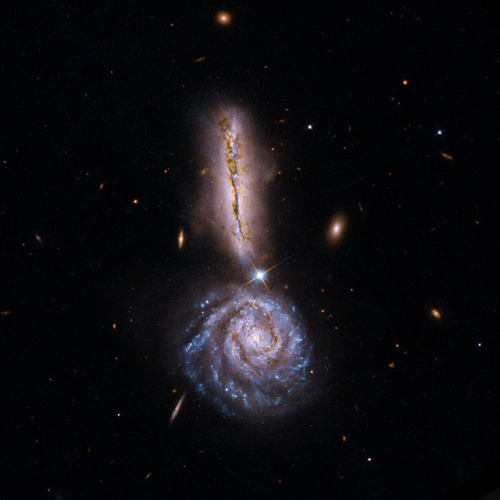
VV 340, pair of interacting galaxies in Boötes. The two galaxies shown here are in the early stage of an interaction that will eventually lead to them merging in millions of years.
Credit: NASA/STScI/NRAO/A.Evans et al
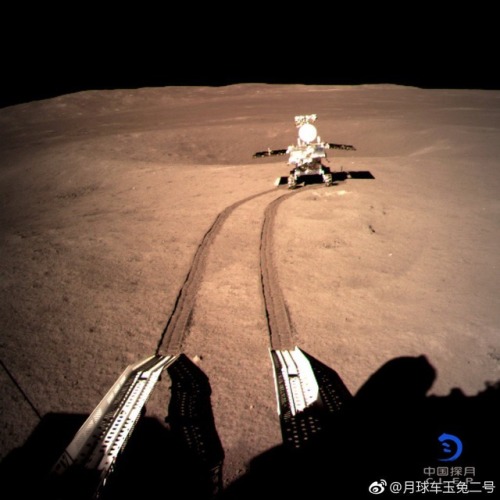
Chang'E-4: The Yutu-2 rover isn’t wasting any time, & has driven away from the lander toward (but not into) a nearby crater. Reminder that all photos from the far side of the moon are being relayed to earth by the Queqiao spacecraft, which is parked in a halo orbit around the Earth-Moon L2 point, about 61,500km behind the moon. “Halo orbit” means it’s about that far behind the moon, but always off to one side or the other from the actual L2 point so it has a line of sight to the Earth. Wouldn’t be much of a relay otherwise.

Our planet seen from Saturn, captured by the Cassini spacecraft
Image credit: NASA
Also being a scientist pretty much gives you a free pass to be as eccentric as you want like you’ll be at a conference and it’s like “is that guy wearing socks and sandals and plaid pants???” “Ya but he was on the team that discovered gravitational waves let him be”

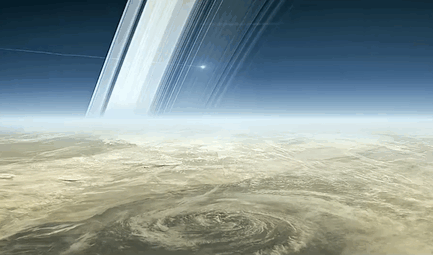
Today the Cassini mission has reached its end…
Gamma-ray Bursts: Black Hole Birth Announcements
Gamma-ray bursts are the brightest, most violent explosions in the universe, but they can be surprisingly tricky to detect. Our eyes can’t see them because they are tuned to just a limited portion of the types of light that exist, but thanks to technology, we can even see the highest-energy form of light in the cosmos — gamma rays.
So how did we discover gamma-ray bursts?
Accidentally!

We didn’t actually develop gamma-ray detectors to peer at the universe — we were keeping an eye on our neighbors! During the Cold War, the United States and the former Soviet Union both signed the Nuclear Test Ban Treaty of 1963 that stated neither nation would test nuclear weapons in space. Just one week later, the US launched the first Vela satellite to ensure the treaty wasn’t being violated. What they saw instead were gamma-ray events happening out in the cosmos!

Things Going Bump in the Cosmos
Each of these gamma-ray events, dubbed “gamma-ray bursts” or GRBs, lasted such a short time that information was very difficult to gather. For decades their origins, locations and causes remained a cosmic mystery, but in recent years we’ve been able to figure out a lot about GRBs. They come in two flavors: short-duration (less than two seconds) and long-duration (two seconds or more). Short and long bursts seem to be caused by different cosmic events, but the end result is thought to be the birth of a black hole.

Short GRBs are created by binary neutron star mergers. Neutron stars are the superdense leftover cores of really massive stars that have gone supernova. When two of them crash together (long after they’ve gone supernova) the collision releases a spectacular amount of energy before producing a black hole. Astronomers suspect something similar may occur in a merger between a neutron star and an already-existing black hole.

Long GRBs account for most of the bursts we see and can be created when an extremely massive star goes supernova and launches jets of material at nearly the speed of light (though not every supernova will produce a GRB). They can last just a few seconds or several minutes, though some extremely long GRBs have been known to last for hours!

A Gamma-Ray Burst a Day Sends Waves of Light Our Way!
Our Fermi Gamma-ray Space Telescope detects a GRB nearly every day, but there are actually many more happening — we just can’t see them! In a GRB, the gamma rays are shot out in a narrow beam. We have to be lined up just right in order to detect them, because not all bursts are beamed toward us — when we see one it’s because we’re looking right down the barrel of the gamma-ray gun. Scientists estimate that there are at least 50 times more GRBs happening each day than we detect!

So what’s left after a GRB — just a solitary black hole? Since GRBs usually last only a matter of seconds, it’s very difficult to study them in-depth. Fortunately, each one leaves an afterglow that can last for hours or even years in extreme cases. Afterglows are created when the GRB jets run into material surrounding the star. Because that material slows the jets down, we see lower-energy light, like X-rays and radio waves, that can take a while to fade. Afterglows are so important in helping us understand more about GRBs that our Neil Gehrels Swift Observatory was specifically designed to study them!

Last fall, we had the opportunity to learn even more from a gamma-ray burst than usual! From 130 million light-years away, Fermi witnessed a pair of neutron stars collide, creating a spectacular short GRB. What made this burst extra special was the fact that ground-based gravitational wave detectors LIGO and Virgo caught the same event, linking light and gravitational waves to the same source for the first time ever!

For over 10 years now, Fermi has been exploring the gamma-ray universe. Thanks to Fermi, scientists are learning more about the fundamental physics of the cosmos, from dark matter to the nature of space-time and beyond. Discover more about how we’ll be celebrating Fermi’s achievements all year!
Make sure to follow us on Tumblr for your regular dose of space: http://nasa.tumblr.com
-
 mage-lore reblogged this · 3 weeks ago
mage-lore reblogged this · 3 weeks ago -
 vinterskald reblogged this · 3 weeks ago
vinterskald reblogged this · 3 weeks ago -
 theradicalkanji reblogged this · 3 weeks ago
theradicalkanji reblogged this · 3 weeks ago -
 bi-loy reblogged this · 4 weeks ago
bi-loy reblogged this · 4 weeks ago -
 boobaloof liked this · 4 weeks ago
boobaloof liked this · 4 weeks ago -
 lonerico liked this · 4 weeks ago
lonerico liked this · 4 weeks ago -
 vesperreverentia liked this · 4 weeks ago
vesperreverentia liked this · 4 weeks ago -
 decept0rcon reblogged this · 4 weeks ago
decept0rcon reblogged this · 4 weeks ago -
 decept0rcon liked this · 4 weeks ago
decept0rcon liked this · 4 weeks ago -
 variable reblogged this · 4 weeks ago
variable reblogged this · 4 weeks ago -
 mortalys reblogged this · 4 weeks ago
mortalys reblogged this · 4 weeks ago -
 radpunch liked this · 4 weeks ago
radpunch liked this · 4 weeks ago -
 elwolfen liked this · 4 weeks ago
elwolfen liked this · 4 weeks ago -
 d3dw1tch liked this · 4 weeks ago
d3dw1tch liked this · 4 weeks ago -
 prismbearer reblogged this · 4 weeks ago
prismbearer reblogged this · 4 weeks ago -
 shin-thalia liked this · 4 weeks ago
shin-thalia liked this · 4 weeks ago -
 renas-rp-hub liked this · 4 weeks ago
renas-rp-hub liked this · 4 weeks ago -
 mooonborne reblogged this · 4 weeks ago
mooonborne reblogged this · 4 weeks ago -
 misszostra reblogged this · 4 weeks ago
misszostra reblogged this · 4 weeks ago -
 lakeinthemoonlight reblogged this · 4 weeks ago
lakeinthemoonlight reblogged this · 4 weeks ago -
 unsuredefleur reblogged this · 1 month ago
unsuredefleur reblogged this · 1 month ago -
 unsuredefleur liked this · 1 month ago
unsuredefleur liked this · 1 month ago -
 valediaz1975-blog liked this · 3 months ago
valediaz1975-blog liked this · 3 months ago -
 gluten-spren reblogged this · 3 months ago
gluten-spren reblogged this · 3 months ago -
 cliriqstars reblogged this · 4 months ago
cliriqstars reblogged this · 4 months ago -
 angelita9914 reblogged this · 4 months ago
angelita9914 reblogged this · 4 months ago -
 bbfashion005 liked this · 6 months ago
bbfashion005 liked this · 6 months ago -
 gemiiniguy liked this · 6 months ago
gemiiniguy liked this · 6 months ago -
 new-wiccan24 liked this · 6 months ago
new-wiccan24 liked this · 6 months ago -
 thesunsetguy reblogged this · 7 months ago
thesunsetguy reblogged this · 7 months ago -
 thesunsetguy liked this · 7 months ago
thesunsetguy liked this · 7 months ago -
 gahl-lak-tus reblogged this · 8 months ago
gahl-lak-tus reblogged this · 8 months ago -
 murdit reblogged this · 8 months ago
murdit reblogged this · 8 months ago -
 madebylayza liked this · 8 months ago
madebylayza liked this · 8 months ago -
 samdaydreams reblogged this · 8 months ago
samdaydreams reblogged this · 8 months ago -
 mapache-marciano liked this · 8 months ago
mapache-marciano liked this · 8 months ago -
 curlycrazes reblogged this · 8 months ago
curlycrazes reblogged this · 8 months ago -
 stellarstunner reblogged this · 8 months ago
stellarstunner reblogged this · 8 months ago -
 all11is11one reblogged this · 8 months ago
all11is11one reblogged this · 8 months ago -
 uhhfuckit liked this · 8 months ago
uhhfuckit liked this · 8 months ago -
 love-in-tongue liked this · 8 months ago
love-in-tongue liked this · 8 months ago -
 psychedelic-sagittarius reblogged this · 8 months ago
psychedelic-sagittarius reblogged this · 8 months ago -
 psychedelic-sagittarius liked this · 8 months ago
psychedelic-sagittarius liked this · 8 months ago -
 c3lestite reblogged this · 8 months ago
c3lestite reblogged this · 8 months ago -
 angelbunies reblogged this · 8 months ago
angelbunies reblogged this · 8 months ago -
 randomblognumberfuck liked this · 11 months ago
randomblognumberfuck liked this · 11 months ago -
 ourladyofserows reblogged this · 11 months ago
ourladyofserows reblogged this · 11 months ago